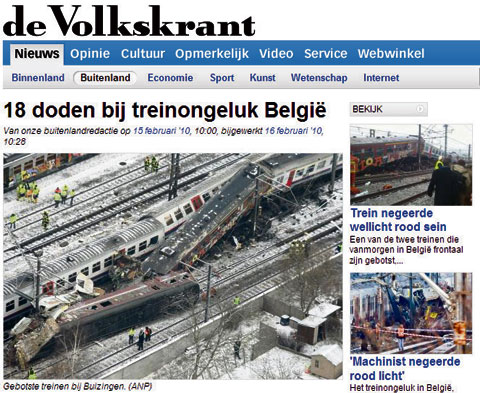Belgium experienced its worst railway crash in thirty years. At least eighteen people died last Monday in a collision between two passenger trains at Halle, just southwest of Brussels.
The most probable cause of the accident is that one of the trains missed a stop signal. Belgium’s rail operator, Infrabel, has launched an investigation.
Safety expert, professor Ben Ale (faculty of Technology, Policy and Management), is very curious to see the outcome. “This accident raises a lot of questions”, he says. “An old passenger train probably missed a stop signal and was hit in the side by another, more modern train. What I noticed when I looked at pictures from the accident scene taken from above is that the old train would have hit a freight train a bit further down the track, if it hadn’t been hit first by this other commuter train. It’s strange that the track operator allowed such a precarious situation to occur.”
In Belgium there is much indignation over the fact that not all trains are equipped with the Crocodil safety system, which automatically stops trains that miss stop signals.
“It’s possible that the train that caused the accident didn’t have this system”, Ale says. “After an accident in Belgium in 2001, in which eight people were killed, the government decided to install this safety system in all trains, starting with the most modern trains. The aim was to have the system on all trains by 2009, but recently they were talking about by 2013. Maybe now they will speed up the installation – I don’t know.”
But even with Crocodil on board, the accident might not have been prevented. Ale: “Crocodil only stops a train that misses a stop if the train is traveling faster than forty kilometers per hour. It’s not clear yet how fast this train was going.”
The Belgium system is almost identical to the Dutch safety system, ATB. According to Ale, accidents like this disaster in Belgium can therefore also occur in Holland.
ATB also only reacts at speeds higher than forty kilometers per hour. The Dutch government had this system installed in the early 1960s, following the country’s biggest train disaster, an accident at Harmelen in 1962 that killed 91 people.
The reason for this ‘speed flaw’ in the system is that when the system was developed in the 1960s, trains that were in stations and had to be moved around (shunted) from one track to another or coupled to another train were also susceptible to the system. If it weren’t for the minimum speed level installed, ATB would automatically stop every train in the station, because there would always be a stop signal given somewhere in the station.
Now of course with more advanced systems and faster computers, it is possible to avoid these problems and install safety system that work perfectly at every speed. The European ERTMS system is one such example.
Why isn’t Holland replacing ATB with ERTMS? “It would cost about one billion euro to do so”, Ale says. “Put very cynically, the question is: do you want to spend that amount of money to spare four lives a year? If you take into account the accident at Harmelen and the casualties thereafter, and divide this by fifty, then that is about the yearly death toll among train passengers in the Netherlands.”
Moet design de wereld redden? Tijdens de Premsela lezing van dit jaar vroeg Henk Oosterling, kunstfilosoof, zich dit hardop af. Als bijna afgestudeerd designer vraag ik mij dit ook weleens af en die vraag werkt verlammend, merk ik. Alles om ons heen is vormgegeven, over nagedacht, ontworpen en weer herontworpen. Alles is design. Dat is nogal wat en er is vooral heel veel van. Waar begin je dan als beginnend designer en wat ga je designen?
Als alles om ons heen design is, lijkt soms het enige dat je nog kunt doen om daar uit te breken, commentaar geven op je eigen discipline. Zelfspot, grapjesdesign, lollige verwijzingen naar eerder ontworpen dingen: Droog design. Of je benoemt jezelf tot Designer, in plaats van gewoon Philippe Starck of Marcel Wanders en vanaf dat moment is iedere bloem of scheet die je laat dus Design: Ego-design. Maar of we daarmee de wereld redden? Deze week begint in Milaan de Salone del Mobile, ‘s werelds jaarlijkse designtentoonstelling. Ik hoop daar in deze over-gedesignde wereld Redders te vinden en geen designers op een gedesigned podium die staan te designen over design met een designerbril op. Want dan komt er weer zo weinig van, van de wereld redden. ‘Goed design is zichtbaar gemaakte intelligentie’ stelde Le Corbusier ooit, en terwijl ik op de fiets over die verantwoordelijkheid peins, stopt naast mij een gestileerde Vespa-rijder met een zwarte helm. Op zijn helm staat drie keer in grote blokletters het woord ‘Design’. Ondanks zijn serieuze blik, kan ik een schaterlach niet onderdrukken. Onze wereld bestaat niet uit zichtbaar gemaakte intelligentie, maar uit zichtbaar gemaakt design. ‘Geen discipline kan in zijn eentje de wereld redden’, concludeert Oosterling aan het einde van zijn lezing. Misschien is dat ook wel niet de vraag die we onszelf als designers moeten stellen. Misschien is de vraag: ’Moeten designers de wereld wíllen redden?’ Daar kan ik wel iets mee. Aan de slag.



Comments are closed.